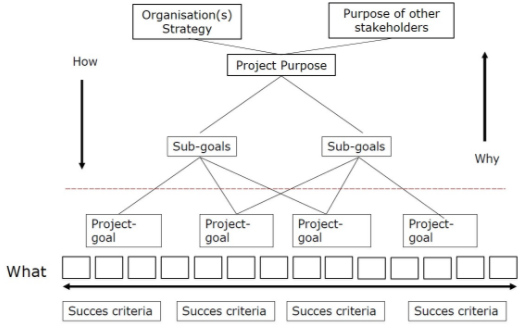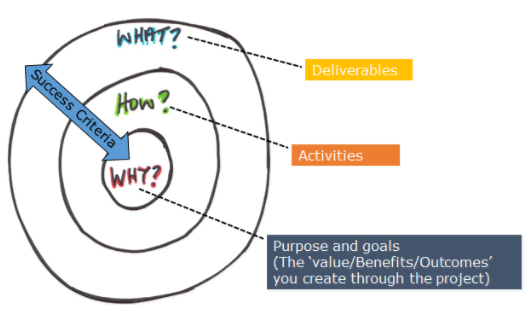Goal hierarchy or Goal Breakdown Structure
(→Abstract) |
(→Abstract) |
||
| Line 2: | Line 2: | ||
| − | Purpose is the reason why a project, program or protfolio exists. A goal hierarchy or goal breakdown structure helps to transform the project purpose into more manageable goals at diffrent levels of importance. This article means to combine two differetn aproches of goal heireachy theory, "the golden circel" and GRIT goal. The goal hierarchy is constructed with a main goal or top level goal, derrived from the main pourpuse of the project, program or portfolio. The mid level and low level goals are then added in a pyramidical structure to construct a more tangibale pathway to achiving the top level goal. The mid and lowl level sub goals are often more concreete tasks and are able to be replaced while the top level goal is more abstract and non-compremiseable (REF: Angela Duckworth). To design the goal heirarchy the "golden circle" stratergy (presented by Simon Sinek) can be applied by asking the questions What, How and Why? The | + | Purpose is the reason why a project, program or protfolio exists. A goal hierarchy or goal breakdown structure helps to transform the project purpose into more manageable goals at diffrent levels of importance. This article means to combine two differetn aproches of goal heireachy theory, "the golden circel" and GRIT goal. The goal hierarchy is constructed with a main goal or top level goal, derrived from the main pourpuse of the project, program or portfolio. The mid level and low level goals are then added in a pyramidical structure to construct a more tangibale pathway to achiving the top level goal. The mid and lowl level sub goals are often more concreete tasks and are able to be replaced while the top level goal is more abstract and non-compremiseable (REF: Angela Duckworth). To design the goal heirarchy the "golden circle" stratergy (presented by Simon Sinek) can be applied by asking the questions What, How and Why? The What questions applie to low level goals, the how questions coresponds to mid level goals and the why questions is meant to determine the purpuse of the project, program or portfolio, the top level goal. |
=Big Idea= | =Big Idea= | ||
Revision as of 11:05, 18 February 2019
Contents |
Abstract
Purpose is the reason why a project, program or protfolio exists. A goal hierarchy or goal breakdown structure helps to transform the project purpose into more manageable goals at diffrent levels of importance. This article means to combine two differetn aproches of goal heireachy theory, "the golden circel" and GRIT goal. The goal hierarchy is constructed with a main goal or top level goal, derrived from the main pourpuse of the project, program or portfolio. The mid level and low level goals are then added in a pyramidical structure to construct a more tangibale pathway to achiving the top level goal. The mid and lowl level sub goals are often more concreete tasks and are able to be replaced while the top level goal is more abstract and non-compremiseable (REF: Angela Duckworth). To design the goal heirarchy the "golden circle" stratergy (presented by Simon Sinek) can be applied by asking the questions What, How and Why? The What questions applie to low level goals, the how questions coresponds to mid level goals and the why questions is meant to determine the purpuse of the project, program or portfolio, the top level goal.
Big Idea
Purpose is the reason why a project exists. However, a purpose alone will not be enough to get the project ‘done’. The goal hierarchy or goal breakdown structure helps transforming and breaking down the project purpose into more manageable goals, sub-goals, and into deliverables, while maintaining a clear direction.
Purpose (why)
Give overall meaning to the project and why it is interesting. It projects the goal of what the project should complete. Identification of the purpose starts by finding the answer the question why.
Deliverables (how and what)
Deliverables or product goals is the final delivery at the project termination. The deliverables describe how the purpose is reached while the project ends. It is the final product emerging from the project. This stage in the hierarchy is the more detailed stage than the purpose.
Success factors
Describes the effect from the deliverables completed in the project. Here is how asked again for instance how can the purpose be measured? Success factors are often defined as the second form in the project initiation phase but during project completion they are measured at the completely end of the project. The idea is to create a hierarchy as displayed in the figure below.
Similar to the argument put forward by Simon Sinek in the so called Golden Circle (see TED talk- add the link to it), we start with why (the purpose), and then move into to define exactly how we will do it (the different tasks) and what (the specific deliverables we need to create).
By creating a relationship between why (purpose, goals and sub-goals), how (activities) and what (deliveries) and success criteria (how to measure whether the goals have been achieved), we provide a clear purpose for all activities being undertaken by the project, which helps increase motivation and engagement with project.
Application
The goal setting is often the very first process initiated after the decision to carry out the particular project, however, depending on the project type some parts of the goal setting will be moved to next stages. As mentioned earlier the goal or purpose makes the desirable picture of the future. According to the book Power of Projects real leadership and management can first be initiated when the goal is defined. To utilize a goal in management the forms purpose, deliverables and success factors are created. By those means the goal can be specific and hence the project will be a project and not just a group of people. The goal hierarchy helps the project team matching expectations, negotiating contracts, engagement of team, coordinating activities, to learn and gain experience. Defining the goal is applicable and important in every project but can differ depending on the project type. The goal hierarchy is also a tool to confine a project – specifically when more projects are started with similar visions. The goal hierarchy and the why, how and what is essential for a project’s further course and measuring of the deliverables at project termination.
Limitations
There is a certain risk that some team members can’t identify themselves with the purpose and they can probably feel overlooked while the deliverables are defined. Leading to less work spirit and team building. As well is there a risk that deliverables and success factors are diffuse and that the correlation between resources and what the team has to deliver isn’t sufficient. It is therefore central to spend time on goal setting and the different forms in the hierarchy. Avoiding being thorough in this part will lead to unsatisfied project members and thus ineffective and counterproductive work causing time and financial waste. Because knowledge is limited in the imitation phase of the project the team doesn’t always know when they have identified best deliverables and best success factors to measure purpose. A too fast forward going approach won’t necessary uncover best deliverables but time and costs will probably already push the team at this stage of the project.
Annotated Bibliography
Attrup, M. L. and Olsson, J.R., 2013
Their book provides back ground knowledge of goal setting in projects as well as providing tools and case examples giving a better understanding of how to deal with goal setting. A goal set the overall direction but they come up with the remaining important features goal setting does for a project. It will be interesting to further read and use on own projects due to the case stories and descriptions of how to use the goal hierarchy appropriately on different sorts of projects.

